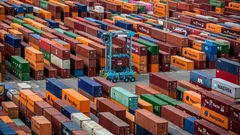Northwest Heat Wave Triggers Blackouts and Buckles Highways
(Bloomberg) -- The rare and powerful heat wave shattering records across the U.S. Northwest is taking a bruising toll on the region’s infrastructure, buckling highways, hobbling public transit and triggering rolling power outages.
Avista Corp. -- which serves nearly 340,000 customers in eastern Washington, Idaho and Oregon -- instituted rolling outages for the first time in company history as temperatures soared. The periodic blackouts had impacted about 4,667 customers as of late Tuesday, with a total of 21,000 warned that they could face disruptions, the company said. Heat also warped Seattle highways and scorched Portland’s streetcar wires, suspending service.
The breakdowns amid the worst recorded heat wave in Pacific Northwest history are the latest sign that unprecedented challenges loom this summer. Heat, drought and wildfires tied to climate change have authorities on edge as they try to keep the power on and avoid more heat-related deaths that claim about 650 U.S. lives annually. President Joe Biden will meet governors of Western states Wednesday to discuss how to address wildfire threats.
In Portland, the mercury hit 116 degrees Fahrenheit (47 Celsius) Monday, a third-straight record, while Seattle notched another all-time high at 108, the National Weather Service said. Lytton, British Columbia -- a region of forests and glacier-fed rivers -- reached 118, a for Canada just one day after shattering a prior high since 1937.
“I have never seen anything like this in my 40 years of forecasting,” said Paul Walker, a meteorologist with AccuWeather Inc. in State College, Pennsylvania.
Biden said Tuesday that the Northwest heat shows why better power networks are needed as climate change induces more frequent and extreme weather events.
“We need to make investments to build a more resilient grid,” Biden said in a speech in Wisconsin, citing an unusual winter storm in Texas that caused the state’s power grid to nearly collapse. “That’s why we need to act,” he said.
Meanwhile, the Northeast also is kicking off a heat wave from Pennsylvania to Maine that could push New York into the upper 90s, the National Weather Service said. Humidity will make it even hotter this week, driving energy demand across the region that relies on air conditioners to beat summer heat.
Consolidated Edison Inc. asked about 270,000 customers in parts of Queens and Manhattan to conserve energy Tuesday evening while the company repairs equipment. Users were encouraged not to use energy-intensive appliances such as washers and dryers. The New York-based utility also said it had reduced voltage levels by 5% to protect equipment.
Boston tied a daily record of 97 Monday, the 10th time this year the city topped 90, while Newark tied a record at 99. The East Coast heat wave however will be different from the Northwest’s because it will reverse in coming days, with rain and a high of just 77 forecast for New York Friday.
“It is hot all over, which is putting a demand on already tight resources,” said Scott Miller, executive director of the Western Power Trading Forum. “There is limited transmission to move generation around. Folks weren’t used to having such high temperatures in the Pacific Northwest.”
The rising heat sent natural gas futures toward the longest winning streak in almost three years and raised power prices, even triggering rare power grid warnings for Eastern states. The Midcontinent Independent System Operator, which spans from central Canada to the Gulf Coast, warned of a potential capacity shortage into the evening because of forced outages.
Other utilities beyond Avista may need to resort to rolling outages as the heat persists through the week, and demand is likely also elevated by the easing of pandemic restrictions and the re-opening of the economy, Miller said.
The average price for day-ahead on-peak power in New England rose 13% Tuesday to the highest for this time of the year since 2008, while New York City’s prices jumped 20% to the the highest seasonal level since 2012, Wood Mackenzie data show.
Seattle’s temperatures also caused some outages in underground power infrastructure, which is harder to fix because of excessive heat in equipment vaults, a municipal utility representative said. About 11,000 customers had no power for around an hour late Monday.
In California, where grid operators may request conservation to avoid outages, dry vegetation helped the Lava Fire near Mount Shasta explode in size overnight. Authorities ordered evacuations and closed roads, a sign of a hard summer to come after a dry winter.
For the Northwest, some cooling in Seattle and Portland is in store as winds from the Pacific Ocean push the heat east over the Cascade Range, though many places in the region will still be in the 90s. That’s rare this time of year in Seattle, which doesn’t usually get hot until later in summer and June is often temperate, even gloomy.
In Vancouver, residents fleeing homes without air conditioning flocked to downtown hotels, queuing for hours in long lines to check in. Air conditioners sold out in stores and online. Peak power demand shattered the prior record by more than 600 megawatts, roughly equivalent to the capacity of some coal power plants.
(Updates with ConEd details in ninth paragraph)
More stories like this are available on bloomberg.com
©2021 Bloomberg L.P.
KEEPING THE ENERGY INDUSTRY CONNECTED
Subscribe to our newsletter and get the best of Energy Connects directly to your inbox each week.
By subscribing, you agree to the processing of your personal data by dmg events as described in the Privacy Policy.
More renewables news

GB Energy Faces New Doubts as UK Declines to Affirm Future Funds

Korea Cancels Planned Reactor After Impeaching Pro-Nuke Leader

Brazil’s Net-Zero Transition Will Cost $6 Trillion by 2050, BNEF Says

SolarEdge Climbs 40% as Revenue Beat Prompts Short Covering

EU to Set Aside Funds to Protect Undersea Cables from Sabotage

China Revamps Power Market Rules In Challenge to Renewables Boom

KKR increases stake in Enilive with additional €587.5 million investment

TotalEnergies and Air Liquide partner to develop green hydrogen projects in the Netherlands

Germany Set to Scale Down Climate Ambitions
















